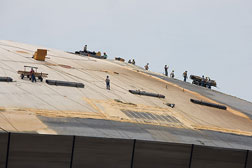 |
| Crews at work in June on Superdome roof panel repairs. (Photo by Michael Goodman for ENR) |
Contractors are grumbling about using their credit, bonding and cash flow to finance the Gulf Coast region’s recovery while they wait for reimbursement from the Federal Emergency Management Agency. Even if the contractors and agencies requesting their services file all of the appropriate paperwork, FEMA representatives can’t give them assurances about when they will be paid. Spokesperson Allison Hadley admitted she “can’t put a timeline” on how long it takes for the funds to be submitted into the state’s account and the state to disburse payment to contractors. That would be a real stretch for me.”
Interestingly, contractors on the high-profile, $125-million Superdome rehabilitation project are not having any problems getting reimbursed by FEMA. “We are getting paid here on a regular basis,” says Roy Mouledous, project executive for Broadmoor, the New Orleans company handling construction management for all of the interior repairs and enhancements.
|
FEMA has allocated $91 million for this project and that money is sitting in an account in Baton Rouge, Mouledous says.
Like many contractors performing emergency infrastructure repairs and debris removal throughout Mississippi and Alabama, Broadmoor also hasn’t been paid on hurricane-related projects that were performed in November and December, he says. However, the involvement of the National Football League, Gov. Kathleen Blanco (D) and media attention have undoubtedly greased the wheels on the Superdome project. “You can’t expect people to do millions of dollars of work and not get paid because that will eventually affect their bonding capacity,” Mouledous says. “On a high profile job like this, they can allocate the funds and make it work, so that tells you something.”
The Superdome is one of 1,565 state-owned buildings, representing $1.75 billion in damages from Hurricanes Katrina and Rita, says Jerry Jones, director of Louisiana’s office of facility planning & control. Damages to those buildings range from $125 million for the Superdome to less than $200, but FEMA has so far agreed to pay for repairs to 30 buildings with more than 50% damage, Jones says. “On a daily basis, I am in hand-to-hand combat with these people. FEMA is in fact, from my perspective, a four-letter word.”
Jones attributes the snail’s pace of reconstruction, in large part, to the agency’s outdated, cumbersome process. “FEMA is stuck in their typical disaster mode and we can’t tell them what to do,” Jones says. “We’re telling them to change the way you operate because it is hurting, not helping.”
The problems are the same in Mississippi says Mike Womack, deputy director of Mississippi Emergency Management Authority, the agency responsible for distributing payments to contractors in that state. In Mississippi, $571 million of $1.2 billion has been disbursed. Of that, the state has disbursed $357 million of an obligated $588 million for debris removal alone. Womack says that it is difficult to determine when those remaining obligated monies will be distributed. “One thing I cannot tell you is how long the contractors have to float the cost, and I can’t tell you if that obligated figure will go up or down,” Womack says. “My guess is that 25% of the completed debris removal work hasn’t been paid.”
Womack thinks it’s past time to re-evaluate the way public assistance is handled. “Quite frankly, there is a shortage of qualified public-assistance FEMA employees, and I think that’s a real problem,” he says.


Post a comment to this article
Report Abusive Comment